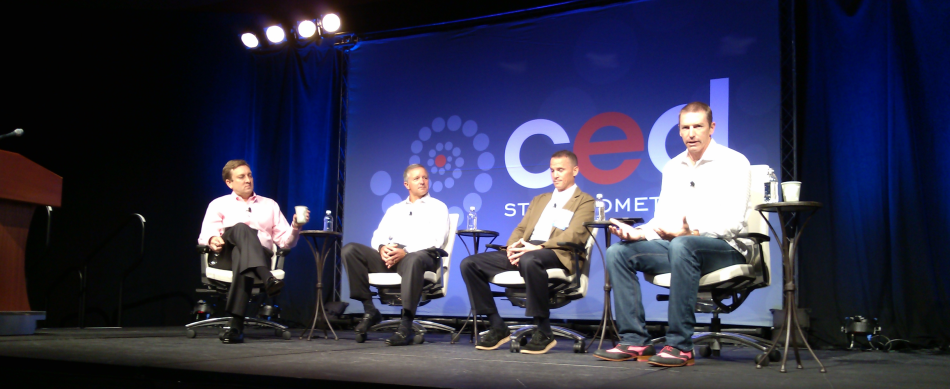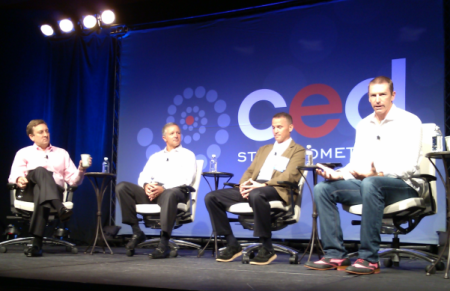
In addition to the great “Lightning Round” pitches, a great M&A panel, and a great demo room, the CED Tech Venture Conference also held a wonderful CEO panel. The many topics of the panel included: When did you realize you had a company? How did you raise funds? How do you hire the right people? How did you learn to be a CEO? It was a very insightful look at some of the less glamorous aspects of being a CEO, and some things that go under the radar.

Left to right: Stephen Wiehe, Mike Cote, David Morken, and Patrick Sweeney
The CEO panel was led by SciQuest CEO Stephen Wiehe, and the participants were Mike Cote, former CEO of SecureWorks (Acquired by Dell), David Morken, CEO of Bandwith, and Patrick Sweeney II, CEO of dwinQ. It is important to note that Mike Cote was brought in by the board of SecureWorks to become the CEO during a troubling period in the companies history, and was not a founder. This is not to say that his experience is any less influential or important, just that his experience as CEO gave him an altogether different perspective than the other panelists. In-fact, Mike proved to be a good counter to the other panelists and offered some real unique takes on some questions
The rationale for the panel was concisely summed up by the leader, Stephen Wiehe:
While you’re growing your business, working day-in and day-out, it’s sometimes hard to realize what it’s like to do this with other businesses. So the discussion this morning is really to give you insight into the lives and operations and thinking of successful CEOs.
At what point did you realize that you had a real company?
The answers that the panelists gave to the first question served as a great barometer, and provided a baseline for all the successive answers.
It’s probably when I go to networksolutions.com. I’m like a 12 year old girl when netsol.com, I have a crush on everything. I think the next domain name that I buy is going to be my next great company.
– Patrick Sweeney, dwinQ
I didn’t enter with complete optimism. I entered realizing we were burning a million dollars a month, and I had 75 employees when I started and we were going to be putting 75 families out of a paycheck in 9 months if we didn’t do something. So my first threshold of thinking we were real was turning cash-flow positive, which took about 18 months.
– Mike Cote, SecureWorks
When that certificate of incorporation arrived with that shiny seal, I felt like I had a real thing but whether it was going to succeed or not was an entirely different question…Cash-flow positive is a big moment, no question about it. But, the first falsifiable experiment that you conduct with customer where they respond and ratify the value prop that you were hoping for is a real eureka moment.
– David Morken, Bandwith
These answers set the tone and provided a great introduction to the personalities and management styles of all three participants, of which all would hold true throughout the panel. On one end you have Mr. Patrick Sweeney, an eternal optimist who seems to run much more on vision, gut, and feelings. On the other end, Mr. Mike Cote approached the position of CEO with much more analytically, and methodically. While in the middle of these two approaches, and physically in the middle, was Mr. David Morken.
What advice would you give those entrepreneurs looking to raise capital?
If I gave any advice on that [raising capital several times over] I don’t think I spent enough time nurturing…I think I should have nurtured more relationships with more firms over time.
– Mike Cote, SecureWorks
We are cash-flowing significantly positive, so its really fun to have 10s of millions of dollars to invest in new and exciting things every year without any dilution. Its intoxicating. So there is a good path if you make it through bootstrapping, but there is opportunity-cost as well.
– David Morken, Bandwith
The first advice [to those seeking funding] would be, don’t do it unless you have to…Everyone was calling us [Odin – a previous company Patrick led] saying ‘we’ve got an opportunity to put money in your company,’ but I had an incredibly smart board member. He said, ‘Are you losing any deals to anyone who’s raised money?’…and he said don’t raise any money. So we bootstrapped over the course of 10 years and had an eight-figure exit. I owned 70% of the company and the employees owned 30%.
– Patrick Sweeney, dwinQ
The only thing I would add to that, I think it’s important whether you raise money or not that you figure out a way to get good advisers around you, and I think the board can do that. Whether you have a few independent board members or some investor board members…Get other people around you that can help you get some advice from outside the company.
– Mike Cote, SecureWorks
Another quick note, don’t be shy about getting board members. I’ve had great board members…I’ll give them 1-2% of the company, which people say, ‘That’s a lot to give’ but, boy a good board member is worth it.
– Patrick Sweeney, dwinQ
More-or-less, all of the panelists agreed that it is important to go it alone as long as possible. Although it is a difficult path, the end results are that much more significant the less-diluted your company is.
How Did You Learn to be a CEO?
I quickly realized that I didn’t have a clue what I was doing, and needed to surround myself with people who did...I focused heavily on bringing in the team around me…The next thing I did was to bring in advisers.
– Mike Cote, SecureWorks
From my experience, two things really stand out. #1 people understand you’re mission oriented; that you have defined, clear, big objectives. #2 and its a close second to #1, and very important to achieving #1, you have got to be someone that gives a rat about people, that actually cares about the people that you will be struggling with to accomplish the mission…That is a powerful magnet for great people.
– David Morken, Bandwith
I think for me it comes down to passion and leadership and being able to sell the dream...If I’m passionate and can sell it and I can show someone what my dream looks like and how we can get there and how we can change the world…If people buy into the vision, then they are a good fit for me, and a good fit for the company.
– Patrick Sweeney, dwinQ
The panelists agree that it is important to bring in good advisers and surround yourself with talented people, and is is equally as important to be fully invested. That is truly believe in what you are doing.
Much like the M&A panel, several key themes emerged in the CEO panel. Firstly, you must believe in, and be passionate about what you are doing. Second, hold off on taking funding as long as you possibly can. But, if you must take money, make sure you have several options and choose those investors that have to most to offer beyond only cash. And finally, know when to take a step back, and let your team do its job. This inflection point is hard to see, but the sooner you realize you are there, the better.
Much more still to come, include an amazing interview with Pete Bell, who sold his company Endica to Oracle for $1 Billion+.


Pingback: TechFaster | The New "New South" on Display at CEDTVC - TechFaster